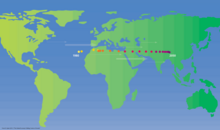
The gravity model of international trade in international economics is a model that, in its traditional form, predicts bilateral trade flows based on the economic sizes and distance between two units.[2] Research shows that there is "overwhelming evidence that trade tends to fall with distance."[3]
The model was first introduced by Walter Isard in 1954.[4] The basic model for trade between two countries (i and j) takes the form of
In this formula G is a constant, F stands for trade flow, D stands for the distance and M stands for the economic dimensions of the countries that are being measured. The equation can be changed into a linear form for the purpose of econometric analyses by employing logarithms. The model has been used by economists to analyse the determinants of bilateral trade flows such as common borders, common languages, common legal systems, common currencies, common colonial legacies, and it has been used to test the effectiveness of trade agreements and organizations such as the North American Free Trade Agreement (NAFTA) and the World Trade Organization (WTO) (Head and Mayer 2014). The model has also been used in international relations to evaluate the impact of treaties and alliances on trade (Head and Mayer).
The model has also been applied to other bilateral flow data (also known as "dyadic" data) such as migration, traffic, remittances and foreign direct investment.
- ^ Quah, Danny (2011). "The Global Economy's Shifting Centre of Gravity". Global Policy. 2 (1). Wiley: 3–9. doi:10.1111/j.1758-5899.2010.00066.x. ISSN 1758-5880. S2CID 55154148.
- ^ Bergstrand, Jeffrey H.; Egger, Peter H.; Toubal, Farid (2024). "Introduction to the special issue on: Gravity at sixty". European Economic Review: 104749. doi:10.1016/j.euroecorev.2024.104749. ISSN 0014-2921.
- ^ Carrère, Céline; Mrázová, Monika; Neary, J. Peter (2020). "Gravity without Apology: The Science of Elasticities, Distance, and Trade". The Economic Journal. 130 (628): 880–910. doi:10.1093/ej/ueaa034. hdl:10419/216556.
- ^ Isard, Walter (May 1954). "Location Theory and Trade Theory: Short-Run Analysis". Quarterly Journal of Economics. 68 (2): 305–320. doi:10.2307/1884452. JSTOR 1884452.
